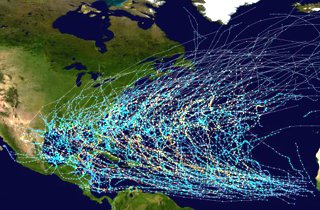“I can see my breath!” I complained during walkies Friday morning.
“Wimp,” a passing resident said almost sotto voce.
It was 15°F colder in Southwest Puffin than in North Puffin on Friday.
Some Solar Deniers would have you believe that Global Warming caused this dip in temperature.
I’m an engineer in real life but I also have a 98% useless undergrad degree in Math.
Today is the last day of the 2015 Atlantic Hurricane season. I took my hurricane shutters down last week.
Terminology: A “hurricane” is a tropical cyclone. In the western North Pacific, these storms are called “typhoons” but similar storms in the Indian and South Pacific Oceans are known as “cyclones.”
Hurricane modeling fascinates me. As the season ends in the Tropics, we relied on computer projections that gave our forecasters the results we see as a colored “cone of uncertainty” on the weather maps. Generally speaking, the models can narrow down a north Atlantic tropical cyclone to a path that falls in the … North Atlantic.
 There are four or five excellent global hurricane forecasting models. Those models solve the equations describing the behavior of the atmosphere over the entire globe. Remember that. These numeric (or “dynamical”) models — called ECMWF, GFDL, GFS, and UKMET — each take hours to run on supercomputers. I was surprised to learn that the U.S. National Weather Service uses the less useful NAM model for only North America and the surrounding waters. There are also statistical models as well as simple trajectory models and hybrid statistical/dynamical models. The National Hurricane Center maintains a list of all of the tropical cyclone track and intensity models.
There are four or five excellent global hurricane forecasting models. Those models solve the equations describing the behavior of the atmosphere over the entire globe. Remember that. These numeric (or “dynamical”) models — called ECMWF, GFDL, GFS, and UKMET — each take hours to run on supercomputers. I was surprised to learn that the U.S. National Weather Service uses the less useful NAM model for only North America and the surrounding waters. There are also statistical models as well as simple trajectory models and hybrid statistical/dynamical models. The National Hurricane Center maintains a list of all of the tropical cyclone track and intensity models.
Here’s one percent of the two percent use that I get from my useless Math degree: I know enough math to know I absolutely could not write the equations for one of these models.
I also know enough math to know the four best hurricane models blither off into uncertainty in a few short days.
“The global warming scam … is the greatest and most successful pseudoscientific fraud I have seen I have seen.”
–Harold Lewis
The IPCC’s man-made Global Warming model simulations cover the period to the year 2100 and beyond. Not five days. Not 500 days. Not even 5,000 days. The IPCC says their model of man-made Global Warming is fixed out to 31,000 days.
Wow.
We can’t predict whether it will rain on South Puffin today (there’s a 10-20% chance) with any certainty but we can predict the temperature there on November 30, 2100.
Wow.
Global Warming models solve the equations describing the behavior of the atmosphere over the entire globe. Sound familiar?
Let’s consider the hurricane models we count on.
Tropical Storm Kate formed out around the Bahamas on a Monday morning just three weeks ago today, an occurrence unexpected by forecasters in the November of an El Niño year. That pries another nail out of climate models, too.
By Veterans’ Day, Hurricane Kate had become the fourth hurricane of the 2015 Atlantic hurricane season. Kate tracked north away from the Bahamas, passed well north of Bermuda, and pretty much bothered only the fishies.
Strong El Niño events typically bring the Atlantic season to an earlier-than-usual close because the subtropical jet stream gets an increasing boost toward late autumn. Despite that, Kate did become a hurricane but was tamed a couple of days later. Dr. Jeff Masters noted that the “only” Atlantic hurricanes observed since 1950 during El Niño Novembers are Ida (2009), Florence and Gordon (both 1994), the “Perfect Storm” (Grace in 1991 which was actually a Halloween storm), Frances (1986), and Martha (1969).
“Only”? Six seems like a lot of “onlies,” since there were November hurricanes in only three non-El Niño years — 1998, 2001, and 2005. (There was also a Cat 1 hurricane in the Azores in December 1951, plus Alice in the Antilles in December-January, 1952, and Lili in December, 1984. 1951-2 was an El Niño year.) I think there have been 21 el Niño years since 1950.
What have we learned?
- I’m thinking Dr. Jeff Masters is as good at hurricane reporting as at global warming prediction.
- If we aren’t good enough at math to predict an atmospheric event as big as a hurricane over a summer, we aren’t good enough at math to predict a 4.3°C temperature change over a century.
- We don’t know how to terraform a planet.
- I hate outdoor walkies when the temperature is 4°C.
Maybe the science ain’t as “fixed” as the Far Green would have us believe, hmmm?
Hmmm, indeed. British public schools used to “cane” students for performance as poor as these predicters keep turning in.

I wrote: “We can’t predict whether it will rain on South Puffin today (there’s a 10-20% chance)…”
And lo, it rained. Not a lot but a few passing showers did come in off the Straits.